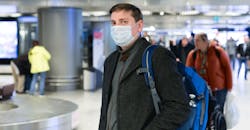Coming off the reliable shot of adrenaline that is the annual AHR Expo, last month’s bustling event in Orlando and the concurrent educational sessions and awards presented by ASHRAE and AHRI, etc., it is hard not to get caught up in all of the excitement about product innovations and continuing market opportunities.
But this year’s event also had an unwanted guest in the hall, and that was, well, fear. A low-grade fear of the Coronavirus pandemic that has only grown more worrisome in the last month. At press time, new cases were being reported in Italy and Latin America, and the White House and Centers for Disease Control were not yet on the same page regarding the U.S. response. All of that was unsettling, to say the least.
In early February, however, the anxiety was just hitting the U.S. Indeed, I first noticed something odd on Super Bowl Sunday, when traffic control personnel outside O’Hare Airport were wearing surgical masks as I arrived, as were a few TSA agents inside. When I boarded my flight to Orlando, I noticed another six or seven Asian passengers also wearing masks. I immediately thought about how I had gone to my local drug store the day before to look for masks and found the entire shelf empty. When I settled into my airplane seat next to a coughing infant, I realized then that I was probably doomed. Even so, I casually held a cocktail napkin next to my nose and mouth for the duration of the trip. I felt silly, but at least it was something.
In Orlando, on the AHR Expo show floor, I did spot some attendees, again mostly Asian, wearing masks. Several folks seemed hesitant to shake hands, and hand sanitizer seemed more prevalent. Also, the number of Chinese-based exhibitors appeared to be down a bit from last year’s show. But all in all, it was very far from any sort of public panic.
And that’s a good thing, of course.
Toward that end, our industry actually can help to quell public health fears. At the show, HPAC sustainability columnist Larry Clark, alerted me to this Feb. 2nd post on LinkedIn by Dr. Stephanie Taylor, MD, MArch, FRSPH (UK), CABE, ASHRAE D.L., that rare physician also learned in the built environment. I immediately shared it with our online audience:
“Ten years ago, we learned that viruses studied as surrogates for Coronavirus, the family of SARS and Wuhan, were INACTIVATED on surfaces when the ambient relative humidity (RH) was 40-60%. Conversely, when RH was either below 40% or above 60%, the viruses remained virulent and infectious.
The opportunity to inactivate viruses in the air and on surfaces by maintaining this range of indoor humidity, which happens to also be the range best for human health, is Mother Nature’s gift to us.
With the excellent indoor humidification systems available, skills of building professionals, scientific acumen of microbiologists and advances in medicine, the time has come for us to co-create indoor environments truly supportive of our health.”
That’s very reassuring. Even inspiring. So, remember that the next time you hear potentially alarming news about this particular crisis, or future public health emergencies. The viruses that threaten us the most can be mitigated by the engineers who control the environmental quality of our indoor lives.
About the Author
Rob McManamy
Editor in Chief
An industry reporter and editor since 1987, McManamy joined HPAC Engineering in September 2017, after three years with BuiltWorlds.com, a Chicago-based media startup focused on tech innovation in the built environment. He has been covering design and construction issues for more than 30 years, having started at Engineering News-Record (ENR) in New York, before becoming its Midwest Bureau Chief in 1990. In 1998, McManamy was named Editor-in-Chief of Design-Build magazine, where he served for four years. He subsequently worked as an editor and freelance writer for Building Design + Construction and Public Works magazines.
A native of Bronx, NY, he is a graduate of both the University of Virginia, and The John Marshall Law School in Chicago.
Contact him at [email protected].
